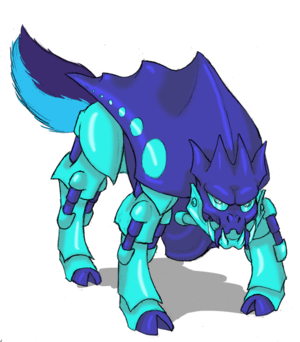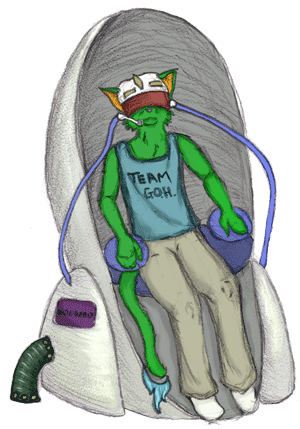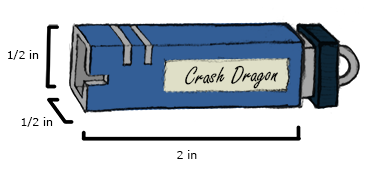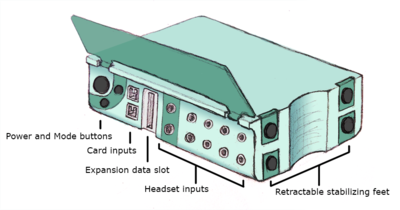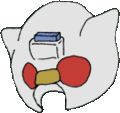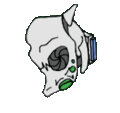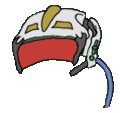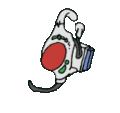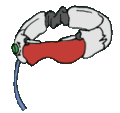Menlo
Menlo is a very realistic Augmented Reality game. Players outfitted in elaborate mechanical suits are pitted against each other in a virtual fight to the death. Menlo matches are played out exactly as they would be in real life. Movement, physics, pain, and damage are all relevant factors during game play.
Menlo suits are mechanical extensions or exoskeletons of the player. The data of an individual suit is held on a device called a Card. Players program these cards to create their personal suits. The design and power of a suit is limited only by the card’s size, and the player’s ingenuity.
Menlo is a very versatile game. While default Game Boards, cards, and headsets can be bought from the MCC, the majority of higher level play involves personal customization of this equipment. Various programmers and mechanics have made careers of selling their custom merchandise to would-be Menlo players. Menlo is constantly evolving and will continue to grow alongside the ingenuity and technology of pendragons.
Contents
Game Play
Due to the highly customizable nature of the game, there are no ‘set’ rules for Menlo. Anyone who makes or programs their own equipment can create any set of rules they desire. Outlined below is the typical MCC set of rules and regulations for game play. This rule set generally serves as a baseline for custom rule sets.
Players begin in the virtual reality world at equal intervals along the edges of the world. There is a short period of time in which the suits cannot be moved or activated. This time can be used for last minute checks and adjustments. The match begins with a sharp siren sound, at which point suits can be moved and operated as normal. A match ends when only one player is left standing and all other players have been killed or disabled.
A player ‘dies’ and is extracted from the game when they are mortally injured, pass out, surrender, or their suit is rendered incapable of moving or functioning. Players in the game do feel pain and will be affected by injury. While this pain is not strictly real, it does have bearing on a player’s ability to continue playing. When a match is over all players are extracted from the game. Suits and game boards are reset to their original conditions.
Game Board Match
Game Board match rules are typically used for practice and recreational matches. There are no standard rules for these types of matches. The rules of any given match are determined by the participants. It is good practice for all players to agree on a set or rules before a match begins. Game Boards that would be purchased from the MCC come pre-programmed with this rule set (or rather lack of rule set) in mind.
- As many players as are desired may participate in a single match.
- Any size card may be used so long as it can be plugged in.
- Because these matches are generally used for practice, it is typical for all players to know the setting of the environment beforehand.
- Some advanced players enjoy using viruses and detachable suit components in matches. It is important that all players be informed if these aspects of gameplay are allowed.
Arena Match
The rules of an Arena match are typically used in tournament style competitions. Each match involves only two players to determine a single victor. Environments and conditions for Arena matches are random and differ with each match. Players do not know the nature of the environment until a match begins, forcing players to be prepared for anything, and testing the integrity of the suits under a variety of conditions. Prior knowledge of an environment generally results in a player being disqualified from a match.
The probationary period at the beginning of an Arena match is longer than in casual matches, typically lasting a half-hour. This gives players and/or their team ample time to test the suit in the gameplay environment, and make any necessary last minute adjustments. During this time the players cannot see or interact with each other.
Arena matches are overseen by an in-game referee. The referee’s suit is hover capable, and entirely defensive in design. It is also equipped with a wide range of sensory capabilities to collect and process as much data as possible. At the end of the probationary period, the referee will sound the siren. The referee overlooks the entire match to ensure no foul play, and declares the winner at the conclusion of the match.
Arena matches almost always take place in a Menlo stadium with a massive audience. The center of the stadium is a large area capable of projecting realistic holograms of the players and game board environment. The audience can also hear the fight over the blaring stadium speakers. While the audience is treated to a larger than life version of their favorite athletes as they compete, players themselves cannot see or hear the audience while in the game.
- Only two players may be in a match at a time.
- Menlo cards must be 2in by ½in by ½in in size (including add-ons), and must be compatible with standard MCC Arena equipment.
- No player may have prior knowledge of the Arena environment.
- Viruses are absolutely forbidden in Arena matches. Any player that is found to have installed a virus in their card will be banned from any further competitions.
- No player may purposefully injure the referee.
- Suits may not be designed with components that operate independently of the suit (such as surveillance bots).
Cards
Cards are small devices that hold all the data necessary for the design and function of an individual suit in the Menlo virtual reality. Everything about a suit must fit on the card. A suit’s design is only limited by the memory space of the card. Cards are plugged into a player’s headset or directly into the Game Board. When a match begins, the player will start the game inside their suit.
The standard card size used by the Menlo Competitions Corporation (MCC) is 2inches by ½ by ½ inches in size, slightly smaller than a tube of chap-stick. However, due to the amount of homemade equipment, cards can be made in almost any size. Some cards are also designed to operate with detachable add-ons or plug-ins. Most cards are designed with some method of attaching the card to a key-ring. This makes it easier for a player to keep track of all of their cards.
Creating a Suit
Creating a suit from scratch is very difficult and complicated. It takes years of study and practice to create the caliber of suit used in professional competitions. Template suits can be purchased from the MCC for beginners to modify.
There are two main ways to construct or modify a suit. The first and most popular method is by directly programming the suit via a computer or programming device. There are a number of software packages that have been developed to help would-be Menlo programmers in this process. The second way is a more recent trend. It involves a specialized ‘Construction’ Game Board, in which the suit can be constructed by hand via the virtual world, just as it would be constructed in the real world. Of course the two methods can be combined, going back and forth as is needed to perfect a suit.
When constructing a suit, physical limitations exist. For example, a player must physically be able to fit inside the suit. The different components of the suit must also be able to physically interact with each other in a real-world way. This is why the construction method of suit building began. It is easier to construct a suit that can actually function when it can be seen and felt. It should also be kept in mind, that only materials that exist in real world Ramath-lehi can be used in construction of a suit.
When coding, most of the available space is taken up by the general physical aspects of the suit such as the materials and forms of the individual components, as well as the functions for movement and power. This does not leave an especially large amount of room for specialized weapons/gadgets/abilities for the suit. For this reason the best suits are created by very experienced programmers and have very concise and efficient code.
Menlo Equipment
Game Boards and Arenas are consoles that essentially hold the Menlo virtual world. All information pertaining to the game’s environment and rules are housed within the Game Board or Arena. Game Boards are used by and sold to the general public. Arenas are essentially the same, but are much more robust and advanced, and come with technology that allows scenes from the virtual world to be projected into the real world. Both have special Administration modes in which specific aspects of the individual match rules and environments can be modified.
Each pendragon that participates in a match does so via a specialized Multi Processing Device typically referred to as a headset. The headset is plugged into or linked to a Game Board or Arena. It is the means by which a pendragon’s consciousness is projected into the virtual reality. Cards are usually plugged directly into the headset. Any displays that appear in the headset can be navigated via thought.
Like everything else of Menlo, Game Boards and headsets are extremely customizable. Described above are official MCC versions, but all Menlo equipment has highly customized versions available.
Other Ways to Play
Menlo Virus Game Play is a very popular sub-genre of Menlo, with a huge following despite the fact that viruses are banned from official Menlo matches. Viruses are strings of code create advantages that extend beyond the physical limitations of the Menlo virtual reality. They work by interrupting existing code in the Game Board, an opponent’s suit, or even one’s own suit.
While Menlo Team Game Play has been around for a while, only recently has an official MCC Team League been formed. Team matches play out much like capture the flag, where each team has a Standard, and a member of the team called the Bearer. A team's Bearer must hold both Standards in order to win a match.
Add-Ons are separate circuit components that can be plugged into a card, adding to the memory space of the card. Plugging these in will add different aspects to a suit, making it easier to customize on the spot. Some add-ons are designed to fit into holes in the card, so that when they are plugged in the whole unit is still regulation card size. Add-ons are not standard practice in official matches, but many professional cards are capable of integrating add-ons, either for testing purposes or for recreational play. They are very popular among more advanced casual players for easily testing a variety of combinations of suit components and abilities.
History
The Menlo game was created by Serin Menlo, and the Menlo Competitions Corporation (MCC). They are responsible for all standards of the game, along with a diverse line of products sold for the game, including Arena equipment, household Game Board systems, headsets, cards, and so forth. They are also the major sponsors of many of the Menlo tournaments. They hold regular competitions, with roughly 100 official Arena matches held annually. Their main competition is held every spring (Dyo Tournament) which is meant to pit the very best Menlo players of the world against each other to come up with an annual Menlo champion.
The Pendragon most responsible for the game’s popularity is Raebin Yanq'fal. He was a young and handsome Pendragon who attracted a wide variety of fans, promoting the game in many social circles. Raebin was the only known Pendragon to win the Dyo Tournament for 3 consecutive years, and may have won many more had it not been for his unfortunate and mysterious demise during one of the matches. His cards are showcased in the MCC headquarters, along with tributes to other Menlo pioneers. He is still considered the best Menlo player ever to live.
Although Menlo is not originally a team sport, in recent years the popularity of team fighting has grown immensely. Generally, rules in these matches are those of the Arena, with the additional rule that team members must each use the same exact suit that has been made for that team. It is rumored and believed that the MCC will soon begin to sponsor official team matches as well. Also, major universities and schools may soon develop teams for aspiring players. (This is slightly different than Game Board team playing. In the Game Board team playing, players have their own, differing suits that they have made, they are simply on opposing teams.)
See Also
Menlo Images
Menlo Gear
| Menlo Gear Part Key | |
|---|---|
| Outer Shell | |
| Visor | |
| Decoration | |
| Card/Card activator link | |
| Adjustable | |
| Buttons/Controls | |
In order to participate in an Augmented Reality Menlo match, all active participants must have a head set. A head set is a modified Multi Processing Device that has been tailored specifically for Menlo game play.
A MCC R112, the very first Menlo head set. Now discontinued.
A MCC R853 head set. The second head set. Still manufactured, but not popular.
A MCC Aviator Helmet head set.
A MCC A06 head set.
A MCC P24 head set.
A MCC P57 head set. Used by professional Menlo players.
A MCC CA-257 head set.
A MCC CU-412 head set. The newest and currently best selling model.
Menlo Suits
Menlo suits, as they appear to the participants and spectators of a match.
Menlo Matches
The following are a list of roleplay threads that contain Menlo matches.
- Menlo Spar
- Lucian and PirateFerret
- At the Local Menlo Arena...
- Firax, A'delos, Silith, PirateFerret, and Kaieta Ultima
- Bring It
- A'delos and Silith
- Menlo Match at Magi Lake
- Lautir, Kitsufox, Silith, Kwoiffei, Fused Eidolon, and PirateFerret
| |||||||||||||||||
